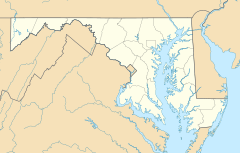Carmody Hills, Maryland facts for kids
Quick facts for kids
Carmody Hills
|
|
|---|---|
| Country | |
| State | |
| County | |
| Time zone | UTC-5 (Eastern (EST)) |
| • Summer (DST) | UTC-4 (EDT) |
| GNIS feature ID | 597183 |
Carmody Hills is a small place in Prince George's County, Maryland, in the United States. It's called an "unincorporated community." This means it doesn't have its own city government or official borders like a town or city.
For counting people and gathering information, the United States Census Bureau groups Carmody Hills with a nearby area called Pepper Mill Village. Together, they are known as "Peppermill Village" for statistics. In 2000, this area was called "Carmody Hills-Pepper Mill Village." Carmody Hills is located near Seat Pleasant Drive, east of the town of Seat Pleasant.
Contents
History of Carmody Hills
Carmody Hills was first planned in the 1930s. It was one of many neighborhoods built around the town of Seat Pleasant during the early to mid-1900s.
How Carmody Hills Grew
Suburban areas in Prince George's County started to grow in the late 1800s. This growth continued through the 1900s. People wanted to live here because it was close to Washington, D.C. They could easily travel to the city using railroads, streetcars, and roads.
Two important transportation lines helped these communities grow:
- The Chesapeake Beach Railway (started in 1898)
- The Washington, Baltimore and Annapolis Electric Railroad (started in 1908)
Changes in Transportation
In the 1930s and 1940s, cars became more popular than streetcars. Highways then became the main way for people in the suburbs to reach the city. The George Palmer Highway was built in the early 1940s. This highway followed the path of the old Washington, Baltimore and Annapolis Electric Railroad. Today, this road is known as Martin Luther King, Jr. Highway.
Building the Community
The first homes in Carmody Hills were built in the early 1930s. More houses and roads were added from the 1930s all the way to the 1970s. By 1942, Carmody Hills was a well-established community. It had about 130 houses arranged in a grid pattern. There were nine streets running north-south and three running east-west.
After World War II, empty lots within the existing blocks were filled with new homes. Between 1957 and 1965, Carmody Hills expanded. It grew one block to the south and several blocks to the east. The Carmody Hills School was also built during this time.
In the late 1960s, a study found that about one-third of the houses in Carmody Hills needed improvements. Efforts to enforce building rules, pave streets, and improve drainage encouraged new house construction in the 1970s. This also made some previously hard-to-reach areas of the community more accessible.



